by Klaus Peper
The 1cm beetle (all photos K. Peper):
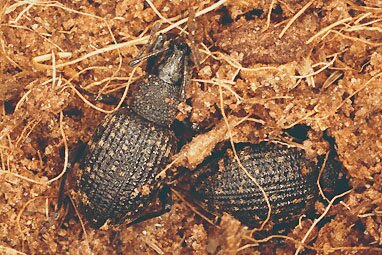
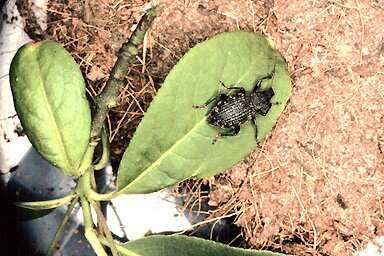
local names:
vaeksthussnudebille (danish)
gefurchter Dickmaulrüssler (german)
gefurchter Lappenrüssler (german)
Vine weevil (english)
black wine weevil (english)
glass house weevil (english)
european strawberry weevil (english)
taxus weevil (english)
charancon noir de la vigne (french)
otiorrhynque de la vigne (french)
otiorrhynque sillone (french)
oziorrinco della vite (italian)
gegroefde lapsnuittor (netherland)
taxuskever (netherland)
veksthussnutebille (norway)
escarbajito de la vid (spain)
bag maymuncugu (turkish)
uurrekorvakaersaekaes (finnish)
farad oeronvivel (swedish)
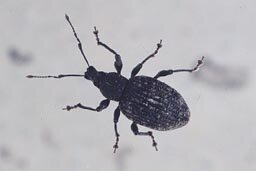
 The weevil Otiorhynchus sulcatus Faber is a snout beetle you likely will never see because at daytime it hides very cleverly. Only sometimes it is crawling in the glass house or even in your apartment where it escaped from pot plants. In autumn the beetle tries to hibernate in warmer spots like your glass house or flat. Inside the living rooms, there is danger neither to the furniture nor to your health. Sometimes it likes to crawl up about 1m on white garden walls, where I found most of my beetles. What you easily detect are the traces of their nightly activities: characteristic holes in your camellia leaves. Whenever you touch a beetle, it will fall down and mimick death material for a while.
The weevil Otiorhynchus sulcatus Faber is a snout beetle you likely will never see because at daytime it hides very cleverly. Only sometimes it is crawling in the glass house or even in your apartment where it escaped from pot plants. In autumn the beetle tries to hibernate in warmer spots like your glass house or flat. Inside the living rooms, there is danger neither to the furniture nor to your health. Sometimes it likes to crawl up about 1m on white garden walls, where I found most of my beetles. What you easily detect are the traces of their nightly activities: characteristic holes in your camellia leaves. Whenever you touch a beetle, it will fall down and mimick death material for a while.

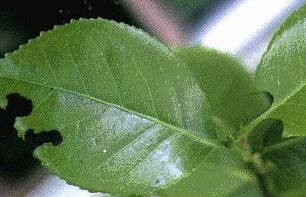
 Whenever you see this kind of holes (which are always open to the leaf margin), and if this occurs to your plants under glass, or even to young plants, be very much concerned. Whereas in the open this type of damage can be tolerated or ignored, it is much more dangerous under glass, because the weevil is said to have several generations here.
Whenever you see this kind of holes (which are always open to the leaf margin), and if this occurs to your plants under glass, or even to young plants, be very much concerned. Whereas in the open this type of damage can be tolerated or ignored, it is much more dangerous under glass, because the weevil is said to have several generations here.

 The Otior(r)hynchus sulcatus (sometimes written with a double 'rr') not only loves camellia, but also rhododendron, vitis, taxus, passiflora, begonia, hederix, cyclamen or euonymus. Weevils are said to be polyphytophageous, i.e. they eat what they see or smell. An infection inside a glass house may destroy complete plant cultures as cyclamen or begonia, where the larvae like to live in the tuberous roots. Commercial indoor plant growers know about the potential danger from the weevil and are trained to combat the beetle and the larvae. In open ground plants, damage may become visible, but is mostly too small to be of any concern.
The Otior(r)hynchus sulcatus (sometimes written with a double 'rr') not only loves camellia, but also rhododendron, vitis, taxus, passiflora, begonia, hederix, cyclamen or euonymus. Weevils are said to be polyphytophageous, i.e. they eat what they see or smell. An infection inside a glass house may destroy complete plant cultures as cyclamen or begonia, where the larvae like to live in the tuberous roots. Commercial indoor plant growers know about the potential danger from the weevil and are trained to combat the beetle and the larvae. In open ground plants, damage may become visible, but is mostly too small to be of any concern.
There seem to be some exceptions: Occasionally young wine plantations are endangered, the larvae eat the roots, and the beetle feed from opening buds. Also the scion of grafted plants can be found girdled. Wine plantations may be completely lost unless immediate action is taken.

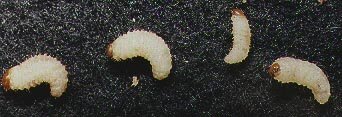
 So what is dangerous to camellias? The leaf holes maybe ugly, but do not kill the plant. Dangerous are the larvae, which live in the ground and eat the roots or girdle the cambium of the stem just underneath the surface. It is likely to loose the complete plant. Thus young plants under glass, especially at plant propergation sites, should be carefully watched.
So what is dangerous to camellias? The leaf holes maybe ugly, but do not kill the plant. Dangerous are the larvae, which live in the ground and eat the roots or girdle the cambium of the stem just underneath the surface. It is likely to loose the complete plant. Thus young plants under glass, especially at plant propergation sites, should be carefully watched.
For the amateur, no action is normally necessary for outdoor plants. To my opinion, the camellias and rhododendrons etc. are not the common feeding plants, very likely there is a much preferred plant like taxus, hedera or euonymus in the neighbourhood, much infested by and the constant source of beetles which escape into sorrounding plants. Thus a combat in camellias would be a nuisance, as long as the source is not clear, and if that should be spotted, beetles cannot be destroyed there because the source plant is too large. (At my site it is a huge Platanus occidentalis, as well as an Euonymus europaeus.
If you detect fresh notches on plants under glass, don't panic. Try to ignore them if not too much plants are infested. You may take a flashlight and gather beetles at night: Young beetles have to feed at least 3-4 weeks before they are matured to lay eggs. Thus here they have a vulnerable period where you can prevent most damage. You can also spray poison in the evening, if carefully done. Else, if plants are outside in summer, combat the larvae next autumn when pots are moved inside, with the recipes given in next paragraph.

 General combat actions are not easy to find. The advice to take a flashlight and gather the beetles at night, only reduces the population for a short time (unless done under glass, in the vulnerable period).
General combat actions are not easy to find. The advice to take a flashlight and gather the beetles at night, only reduces the population for a short time (unless done under glass, in the vulnerable period).
Larvae: A rather simple method is the use of bacteria infected nematodes ( Heterorhabditis spec.) which kill weevil larvae. You can order these nematodes in a good plant shop, they are send to you. Apply these in autumn, when beetles stop to lay eggs. The nematodes method works at temperatures above 13°C. Else insecticides are indicated. Contact your plant protection center. Very effective is parathion-ethyl (E-605), a highly poisonous anticholine esterase, in many countries not allowed for amateurs. It is poisonous to humans if sprayed, but less dangerous if pots are immersed into a solution for 15 minutes. After killing the larvae, E-605 is destroyed quite quickly in the soil and then no longer harmful. Do this when plants are still outside. A new treatment may be necessary not before several years.
Beetles: When beetles occur under glass, nematodes are not send, it is too cold outside. Also, nematodes may not work on beetles, and larvae may have already converted to beetles. Then contact poison (again, e.g., E605) can be sprayed to the leaves, but apply, if possible, outside the house. In any case wear gloves and don't smoke. Read the instructions.

 Obviously parathion is the only effective poison against the larvae. There are others to combat the beetle, but this is not very effective. In some countries amateurs are not allowed at all to apply insecticides. Please contact the appropiate governmental site for plant health, ask for a special permit. A single treatment of all potted plants was effective for 2-3 years at my camellia collection.
Obviously parathion is the only effective poison against the larvae. There are others to combat the beetle, but this is not very effective. In some countries amateurs are not allowed at all to apply insecticides. Please contact the appropiate governmental site for plant health, ask for a special permit. A single treatment of all potted plants was effective for 2-3 years at my camellia collection.

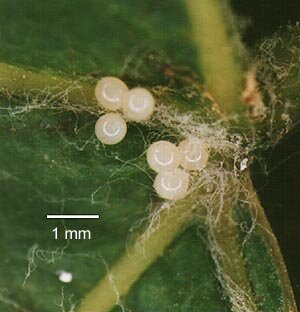
Adult beetles lay their white eggs (0.6mm) into soil or leaves.
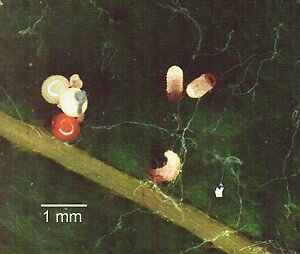
Later the eggs turn brown. After about 8 to 15 days the small larvae hatch. They will increase tenfold during summer.

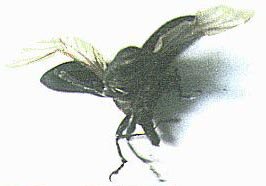 Q:Is'nt the biology of the weevil doubtful? Most papers report that it is wingless and cannot fly, but see the snapshot of 'my' beetle trying to escape the heat of the photographing lamp! Allegedly Otiorhynchus is only female: I found a picture of mating beetles. So what are they doing?
Q:Is'nt the biology of the weevil doubtful? Most papers report that it is wingless and cannot fly, but see the snapshot of 'my' beetle trying to escape the heat of the photographing lamp! Allegedly Otiorhynchus is only female: I found a picture of mating beetles. So what are they doing?
A: There are many different species of weevils around. What you see in the picture is definitely not the Otiorrhynchus sulcatus (the snout is different!). Shure, you can meet mating beetles, but not in our species! (With the exeption of Italy, where allegedly some males have been spotted)

 P.S. I recently learned that O. sulcatus, also called glass house weevil, or black wine weevil, is only female in large regions in Europe, males are found very seldom in other regions. Other sources tell that in this species males were never found. The beetles lay several hundred unfertilized eggs which develop into larvae and female beetles again (Parthenogenesis). If the conditions are suitable, and with Camellias they are, the weevil population can explode this way ( like aphids). This makes weevils so dangerous. There are possibly several species involved, which may differ. The fir weevil O. niger is said to have only rudimentary wings. In Germany the group is called 'Dickmaulrüßler' (big mouth weevil), please send me more native names.
P.S. I recently learned that O. sulcatus, also called glass house weevil, or black wine weevil, is only female in large regions in Europe, males are found very seldom in other regions. Other sources tell that in this species males were never found. The beetles lay several hundred unfertilized eggs which develop into larvae and female beetles again (Parthenogenesis). If the conditions are suitable, and with Camellias they are, the weevil population can explode this way ( like aphids). This makes weevils so dangerous. There are possibly several species involved, which may differ. The fir weevil O. niger is said to have only rudimentary wings. In Germany the group is called 'Dickmaulrüßler' (big mouth weevil), please send me more native names.

 In an apartment house near Heidelberg, a plant lover reports that flower trays, build at all stories in front of the house, are infested with weevils, about 6-10 larvae per liter soil. They eat everything planted to the trays. Inhabitants tried all methods to get rid of this pest, in vain. Some consider seriously to sell their flat.
In an apartment house near Heidelberg, a plant lover reports that flower trays, build at all stories in front of the house, are infested with weevils, about 6-10 larvae per liter soil. They eat everything planted to the trays. Inhabitants tried all methods to get rid of this pest, in vain. Some consider seriously to sell their flat.
 In a Chinese book I found a weevil( Zeuzera spec. ), which bores camellia seed like our hazelnut borer (Balaninus nucum). We better don't import this in our countries.
In a Chinese book I found a weevil( Zeuzera spec. ), which bores camellia seed like our hazelnut borer (Balaninus nucum). We better don't import this in our countries.
 There are about 10.000 different species of weevils in the family Curculionidae. It was recently said that 70% of potato harvest was destroyed by a weevil in Chile this year (1996). Relatives of our 'camellia lover' are most dangerous in pine forests. They are wood killers.
There are about 10.000 different species of weevils in the family Curculionidae. It was recently said that 70% of potato harvest was destroyed by a weevil in Chile this year (1996). Relatives of our 'camellia lover' are most dangerous in pine forests. They are wood killers.

 If you have any experience with or knowledge on this beast, please let me know, I would be happy to post it here.
If you have any experience with or knowledge on this beast, please let me know, I would be happy to post it here.
 Send me your weevil!
Send me your weevil!
 If you manage to catch a beetle, or a larvae, please put it in a plastic bottle (film container) in 70% ethanol and send it to me for classification.
If you manage to catch a beetle, or a larvae, please put it in a plastic bottle (film container) in 70% ethanol and send it to me for classification.
Thank you!
 ] [Pests & Diseases
] [Pests & Diseases  ] [ Weevil ]
] [ Weevil ]
 ] [Pests & Diseases
] [Pests & Diseases  ] [ Weevil ]
] [ Weevil ]

 The weevil Otiorhynchus sulcatus Faber is a snout beetle you likely will never see because at daytime it hides very cleverly. Only sometimes it is crawling in the glass house or even in your apartment where it escaped from pot plants. In autumn the beetle tries to hibernate in warmer spots like your glass house or flat. Inside the living rooms, there is danger neither to the furniture nor to your health. Sometimes it likes to crawl up about 1m on white garden walls, where I found most of my beetles. What you easily detect are the traces of their nightly activities: characteristic holes in your camellia leaves. Whenever you touch a beetle, it will fall down and mimick death material for a while.
The weevil Otiorhynchus sulcatus Faber is a snout beetle you likely will never see because at daytime it hides very cleverly. Only sometimes it is crawling in the glass house or even in your apartment where it escaped from pot plants. In autumn the beetle tries to hibernate in warmer spots like your glass house or flat. Inside the living rooms, there is danger neither to the furniture nor to your health. Sometimes it likes to crawl up about 1m on white garden walls, where I found most of my beetles. What you easily detect are the traces of their nightly activities: characteristic holes in your camellia leaves. Whenever you touch a beetle, it will fall down and mimick death material for a while.
 If you manage to catch a beetle, or a larvae, please put it in a plastic bottle (film container) in 70% ethanol and send it to me for classification.
If you manage to catch a beetle, or a larvae, please put it in a plastic bottle (film container) in 70% ethanol and send it to me for classification.